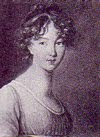Quilts, by name, imply warmth and cosy colours but I have made quite a few in bright, spring-like prints or shades. When it comes to reproductions, however, I only seem to have one that shouts “Spring!” and that one has already been featured in the background of a photograph on this blog (http://historyknits.blogspot.com/2011/01/when-i-am-not-knitting_31.html) That delicate 18th century print was part of a line manufactured by P&B Textiles called the DAR Museum Collection from, obviously, the DAR Museum in Washington, DC. The complete line dated from 1780-1830 and represented a wide range of printing techniques including woodblock and roller prints.
I have, however, a quilt top (pictured here) that has been perpetually in
progress as I use it to demonstrate hand piecing. It has lovely reproduction
prints from the late 18th through the mid-19th century,
and, like a few other reproduction quilts I have made, the fabric has been
culled from mail-order samples and fat quarters I have found in shops or at
shows that I absolutely had to have or I would die on the spot.
Not squares on point this time but elongated triangles or
pyramids, sewn in strips and then the strips sewn in reverse to each other. The triangles each measure 3" high and 3 ¼ wide at the base. I
am not even going to try to name a pattern as there are so many variations on
the basic ones. Safe to say, this quilt, like most of my reproduction ones,
celebrates the prints and, when finished, will have a square quilted over hexagons
of pyramids.



















